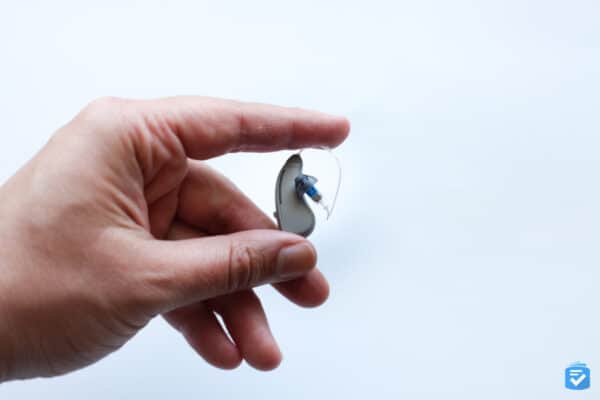The Best Behind-the-Ear Hearing Aids in 2025, Audiologist-Reviewed
In the past few years, Receiver-in-Canal (RIC) style hearing aids, which are worn behind the ear, have incorporated a variety of features that go well beyond amplifying sounds. RIC hearing aids sit behind your ear, just like a traditional Behind-the-Ear aid, but are usually smaller and have a wire instead of a thick tube.
Within the hearing aid industry, these aids are always called RICs, in this article, we refer to them as BTEs to provide clarity about their location on the body to those not yet familiar with industry terms. Our favorite BTE devices can reduce background noise, stream phone calls, and even link up with a smartphone for remote adjustments. Whether you’re looking to upgrade your old devices or explore the best OTC hearing aids, we’ve got you covered. We’ve tried over 30 different hearing aid models from 12 manufacturers; we then narrowed them down to three options based on affordability, sound quality, performance, and support.
Pro Tip: Not sure what fit, style, or brand of hearing aids to choose? Read our hearing aid buying guide.
Why Trust TheSeniorList?
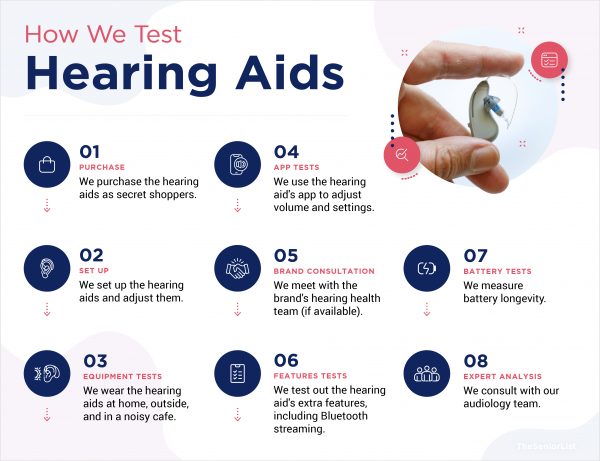
To create this list, our team tested 20 different hearing aid models from eight brands. As we evaluated them, we used the following criteria:
- Comfort: We looked for lightweight hearing aids, fit easily into the ear canal, and provide a comfortable and flexible fit that can be worn daily.
- Affordability: BTE hearing aids can be more affordable than other styles, so we tried to find hearing aids that were less than $3,000 per pair.
- Size: We looked for brands that offer a range of size, color, and shape options for behind-the-ear hearing aid models. Larger hearing aids often have longer battery life and better amplification and sound quality than more discreet models.
- Performance: We wanted hearing aids that don’t require constant battery charges or replacements. We also focused on hearing aids that provide optimal performance through dual microphones and were able to reduce feedback and unwanted whistling noises.
- Additional features: We looked for hearing aid models with special features like Sound Match technology, more channels, and Bluetooth connectivity. These additional features help make hearing aids a worthwhile investment.
The Best BTE Hearing Aids
- Enhance Select 50R : Best Smartphone Features
- Lexie B2 Plus : Best Sound Quality
- MDHearing VOLT : Best Budget Option
Our Top Picks Compared
|
Enhance Select 50R
 |
Lexie B2 Plus
 |
MDHearing VOLT
 |
|
|---|---|---|---|
| Rating out of 5 | 4.8 | 4.4 | 4.1 |
| Cost for a Pair | $995 – $1,195 |
$999 |
$397 |
| Warranty | 1 – 3 years |
1 year |
1 year |
| Standout Features |
|
|
|
| Read More | MDHearing VOLT Review |
The Best Behind-the-Ear Hearing Aid Picks for 2025
1. Enhance Select 50R - Best Smartphone Features
 View Packages
Links to Jabra Enhance
View Packages
Links to Jabra Enhance
What We Like Most:
- Personal support from trained audiologists
- Direct streaming from smartphones
- Adjustable settings through the Jabra app
- Up to three-year warranties

Overview
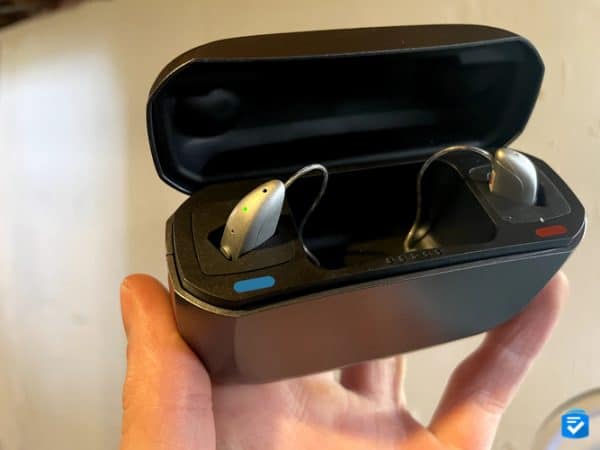
Cost for a pair: $995 – $1,195
Featuring long-lasting rechargeable batteries, IP68 water resistance, and one of the best smartphone apps around, the Jabra Enhance Select 50R is an all-around great choice for an BTE hearing aid.
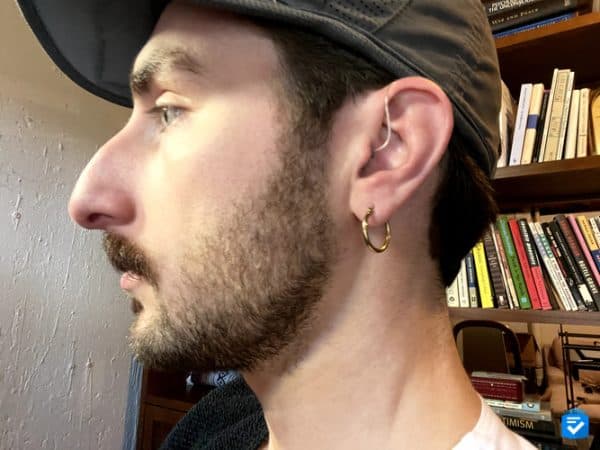
In our tests, this hearing aid worked very well in both quiet and loud environments. In particular, we were impressed with how it could drown out background noise in a crowded cafe, allowing us to focus on immediate conversations. Additionally, through the Jabra Enhance app, we could adjust the volume and frequency levels of our hearing aids. Jabra Enhance Select 50R hearing aids are the only device on this list that supports the streaming of both phone calls and music. Essentially, we could use them like AirPods; plus, with their water resistance, we could listen to music at the gym without worrying about damaging them with sweat.

>>Read more: The Best Hearing Aids for Active Users
Priced at $1,195 for the premium package, Jabra Enhance hearing aids cost more than the other devices on this list. The benefit of opting for this package, however, comes from an extended three-year warranty and three years of remote support from their hearing specialists. In our tests, these specialists were able to help us understand our hearing aids, and they could even make adjustments from afar during our Zoom calls.
To learn more about the models from this company, read our full Jabra Enhance hearing aids review.
Pros
- Three-year manufacturer’s warranty
- Half the price of prescription hearing aids
- 24-hour battery life
- 100-day return period
- Remote hearing adjustments
- Bluetooth connectivity
Cons
- Professional support only available with the Premium package
- Not intended for people with severe hearing loss
2. Lexie B2 Plus - Best Sound Quality
What We Like Most:
- Easy adjustments via Bluetooth
- Great sound quality
- Under $1,000 for a pair
- Direct phone call streaming
Overview
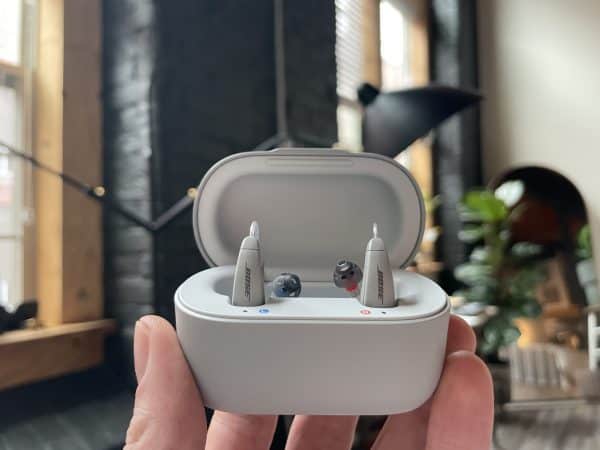
Cost: $999 for a pair
Built with Bose hardware, the Lexie B2 Plus hearing aids demonstrated the most exceptional sound quality of any devices we tested. Unlike the Jabra Enhance or MDHearing models, which sometimes suffered from “wind noise,” Lexie’s hearing aids performed equally well indoors and outside. Additionally, through the Lexie app, we could fine-tune our hearing aids via smartphone. For example, when we took them into a crowded restaurant, we could adjust the directionality of the hearing aids — focusing on the sounds in front of us while drowning out the surroundings.

The one downside of Lexie hearing aids is the lack of music streaming. While we could stream phone calls to our B2 Plus hearing aids, we could not stream music or other audio. Considering how Bose is known for its headphones and speakers, we thought this was a bit of an oversight.
To learn more about all of Lexie’s models, read our full Lexie hearing aids review.
Pros
- Exceptional sound quality
- Phone call streaming for iPhones
- In-app hearing test and adjustments
- Unlimited customer support
Cons
- No music streaming
- No water resistance
3. MDHearing VOLT - Best Budget Option
What We Like Most:
- Highly affordable
- 18-hour battery life
- Portable charging case
- Four environment settings
Overview
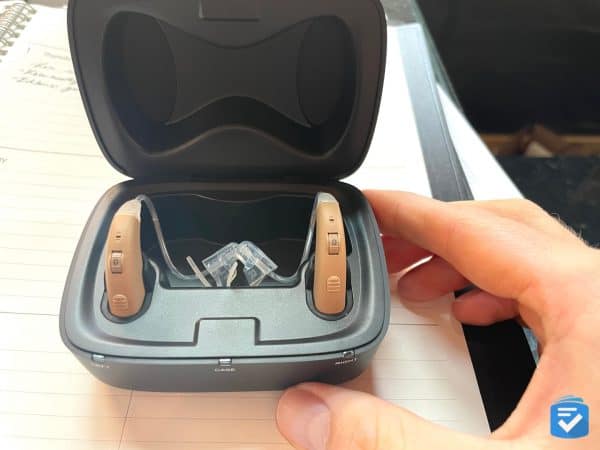
Cost for a pair: $397
Of the three hearing aid models offered by MDHearing, the rechargeable and water-resistant Volt is our favorite RIC model. It can withstand water up to three feet for 30 minutes; plus, it features improved battery life and directional microphones that focus on important conversations in front of you rather than background noise. Volt hearing aids are also equipped with advanced feedback-cancellation technology that eliminates whistling, buzzing, and other unwanted noises.

The primary downside of Volt hearing aids is that they don’t have any smartphone functionality; there’s no Bluetooth streaming here. Also, to toggle between sound settings, we had to press the dial on the hearing aids themselves, rather than use a smartphone app, as with Jabra and Lexie’s devices. That said, if you don’t use a smartphone, then this might not matter all that much.

Of all the hearing aids on this list, MDHearing costs the least by far. While they do lack smartphone connectivity and remote adjustments, they perform better than any other hearing aid in this price bracket.
To learn more about MDHearing’s other models, read our MDHearingAid review.
Pros
- Rechargeable batteries
- Water-resistant design
- Directional microphones for background noise reduction
- Four sound settings
- 45-day risk-free trial
- Free lifetime support
Cons
- No remote adjustments
- No Bluetooth capabilities
- No customization settings
Honorable Mentions
The following hearing aids performed well in our tests. However, for one reason or another, they did not make our final list.
- Audicus: Audicus hearing aids impressed us with their smartphone connectivity; however, we found their sound quality wasn’t quite on par with that of Lexie or Jabra Enhance.
- Eargo: In our Eargo reviews, we were impressed by these hearing aids’ automatic sound adjustments; however, the company does not currently offer a BTE model.
- ReSound: ReSound hearing aids impressed us with their sound quality; however, their BTE models start at $2,500 for a pair, and they often cost far more.
- Starkey: Similar to ReSound, Starkey hearing aids work exceptionally well, but they often cost well over $3,000 for a pair.
- Audien: Starting at $99, Audien makes arguably the most affordable hearing aids; however, in our reviews of Audien, we found that their sound quality is not worth the cost of entry, however low it may be.
What are BTE Hearing Aids?
BTE hearing aids are the most traditional style on the market. They fit snugly over your outer ear and behind your ear, and they have special tubing or wiring that delivers sound directly to your ear canal.
We recommend BTE hearing aids if you have only high-frequency hearing loss; if you’re on a budget and don’t mind people occasionally noticing you’re wearing hearing aids; or if you’re interested in streaming audio such as phone calls, music, and audiobooks from your phone. Many BTE hearing aids now have rechargeable batteries, a smaller design, directional microphones, and connectivity options.
Bottom Line
BTE hearing aids are not as discreet as some other styles. However, they offer some of the most powerful technology, and they’re great for just about any user.
To learn more about BTE hearing aids — as well as other designs — check out our rundown of this year’s best hearing aids.
Additionally, check out our helpful guides and reviews:
Frequently Asked Questions
-
How do BTE hearing aids work?
BTE hearing aids are placed behind your outer ear, and contain a small tube or wire for sound to travel into your ear canal.
-
What is the difference between BTE and in-the-ear hearing aids?
BTE hearing aids are typically more noticeable than in-the-ear hearing aids, which are placed directly inside the ear canal. BTE hearing aids have a speaker placed inside the hearing piece.
-
How do you keep BTE hearing aids in place?
You can keep BTE hearing aids in place by making sure the tubing or wire is the proper length. You can also purchase accessories such as retaining clips or surgical tape to make it more comfortable for everyday wear.
-
Do BTE hearing aids interfere with glasses?
You can still wear BTE hearing aids with glasses. If you’re worried about comfort, then you can look into other styles, such as invisible-in-canal hearing aids.


